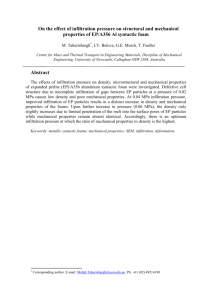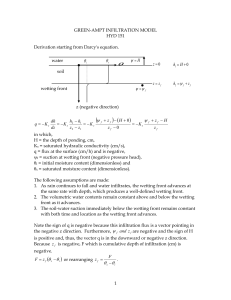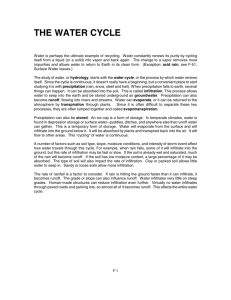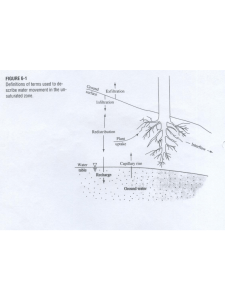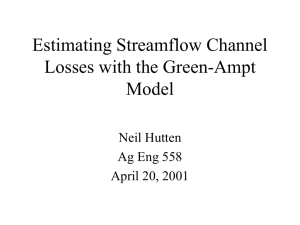Next adventure: The Flow of Water in the Vadose Zone
advertisement
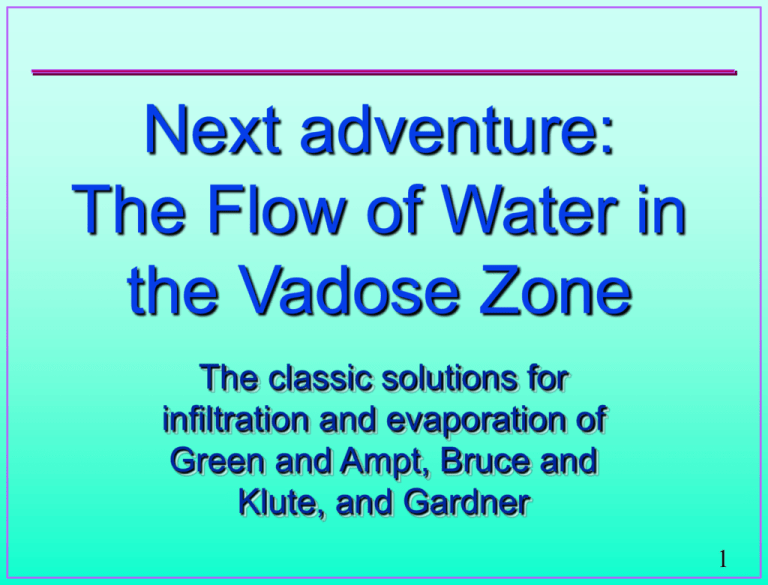
Next adventure: The Flow of Water in the Vadose Zone The classic solutions for infiltration and evaporation of Green and Ampt, Bruce and Klute, and Gardner 1 The Green & Ampt model for Infiltration Conceived of in the framework of a capillary tube bundle concept: Media is modeled as a bundle of capillary tubes oriented in the direction of infiltration. Tubes fill in parallel to the same depth (i.e., the wetting front is at a welldefined position, the same in all tubes). d L 2 Goals May be employed in calculating the infiltration into soils which proceed at any angle relative to vertical by simply adjusting the magnitude of gravity. We will carry out some 1-dimensional calculations Calculate the horizontal rate of infiltration into a dry soil. Solve for ponded vertical infiltration. Solve for falling head vertical infiltration. Note: This conceptual approach can be applied to multidimensional problems. 3 The basic idea: Infiltration is driven by two forces: Force of gravity acting on the water. d L Pressure drop produced by a sharp wetting front Assumptions: Wetting front is completely “sharp” Soil is saturated behind wetting front 4 The wetting front potential term Where does this term come from and what is its magnitude? Let’s take the case of soil made up capillary tubes of N sizes, Each of the sizes makes up a fraction ai of the total cross-sectional pore area. The porosity n is N a i 1 i = n 5 Continuing on the wetting front potential Part of the potential gradient is generated by the capillary contacts. Pressure due to capillary contacts will result in a force per unit area. The force is proportional to the length of solid/liquid contact per unit area. For a unit of cross-sectional area, total length, la, of water/solid contact is N la = area of tu be i w all len gth of i u n it area area of tu be i [3.1] i =1 N la = i =1 2 ri ai r i2 N = i =1 2 ai r i [3.3] 6 N la = 2 ri ai r i2 N = 2 ai r i [3.3] i =1 i =1 •Assume a contact angle of f •The pressure per unit area, Pf, at the water/solid interface is N Pf = l a cos = cos 2 ai r i [3.5] i =1 •Resistance to flow? Poiseuille capillary flow! For the ith tube, we have the flow per unit area, qi, of qi ri 2 DP = 8L [3.6] Where P is the pressure drop across a capillary tube of length L with a fluid flowing with viscosity . 7 Computing flux qi ri 2 DP = 8 L [3 For our capillary bundle the total flux would be N q= r i 2 P ai 8L P N = a i r i 2 8L [3.7] i =1 i =1 If the flow is horizontal, then the driving force is simply the surface tension, so the pressure drop in the tubes is Pf and the flux into the system is given by Pf N q = a i r i 2 8L [3.8] i =1 For “convenience,” let’s define the system constant N K = i =1 g a i r i 2 [3.9] 8 8 N K = g a i r i 2 [3.9] 8 i =1 We recognize K as the saturated hydraulic conductivity. In the customary units of pressure head ghf =Pf [3.8] is Khf q L [3.10] Now hang on there! That looks like Darcy’s Law! If we have a soil with wetting front potential hf and conductivity K, then the flux would be: h f q KH K L So we have just found Darcy and seen how the terms relate to capillary properties. 9 So Solving for infiltration Khf q L The soil is going from dry to saturation, we can relate the flux to the rate of movement of the sharp wetting front d q = dt nL [3.11] Combining [3.10] and [3.11] we obtain a differential equation for the position of the wetting front in time dL Khf n dt L [3.12] 10 Wait, we can solve this! dL Kh f n dt = L [3.12] 2 integrate to find that n L = K hft 2 [3.13] or, solving for the length of infiltration L= 2K h ft n [3.14] the wetting front advances with the square root of time. the total infiltration is also proportional to the square 11 root of time. We may now compute flux Recall d q = dt nL L= 2K h ft n [3.11] So we may put in the result for L and take the derivative d 2 Kh f t q= n q = dt n Kh fn -1/ 2 2 t = 1/ 2 SGA t [3.15] [3.16] where SGA (referred to as the sorptivity) is a constant dependent on the media, and equal to (2nKhf)1/2. Key observation: Horizontal flux decreases proportionally to one over the square root of time. 12 Let’s look at effects of soil texture Plugging in our previous results SGA 2 N n cos ga r 2 a i i i i 1 gr i = 2 [3.17] To help “see” how SGA relates to soil characteristics, make the vastly simplifying assumption that the soil has only one pore radius. SGA becomes 2 SGA cos r = =Cr 2 [3.18] where C is a constant which depends only on the fluid. This then tells us that for our simplified soil that the infiltrating flux will be given by q= C r t [3.19] 13 Let’s look at this... q= C r t [3.19] Infiltrating flux goes with the square root of the radius. Compared to conductivity which goes with r2. Why the difference? The larger surface area of the particles in the finer soil provides a large capillary “pull” into the soil, which is almost enough to overcome the lower hydraulic conductivity. 14 Next stop: Vertical infiltration Essentially as easy as solving for horizontal infiltration. Ponded infiltration: Darcy's law for the system is simplified by the fact that the wetting front is assumed to be sharp, with saturation behind the front head loss q = -Ksat [3.20] length of travel The head loss across the system is the sum of the potential at the wetting front, hf, the depth of ponding, d, plus the depth of infiltration, L, while the length of travel is L d h f+ d + L n L = K [3.21] sa t dt L 15 d h f+ d + L d t n L = Ksa t L [3.21] Vertical, constant head infiltration Separating variables n L dL dt = K sa t h f + d + L hf + d n = K 1 dL h f + d + L sa t [3.22] which may be integrated to obtain n h f+d+L t= K L - (h f+d)ln [3.23] h f+d sa t Square root of time behavior for horizontal infiltration replaced with logarithmic relationship. Note: taking Taylor expansion at short time, the horizontal and vertical results become identical 16 Vertical falling head... Same procedure can solve for infiltration under falling head. In this case, we replace the depth of ponding, d, with this depth minus the depth of water which has infiltrated, nL (where nL<d, after which the pond is gone). Using (3.20) as before, we obtain n h f+d+L(1-n ) t= 2 L(1-n ) - (h f+d)ln h +d Ksa t (1-n ) f [3.28] 17 Typical Results 35 Depth of Infiltration (cm) 30 25 20 15 Falling Head 10 Constant Head Horizontal 5 0 0 50 100 150 200 250 Time (seconds) Green and Ampt model predictions for infiltration in a soil with 30% pore space, Ks = 0.03 cm/sec, hf = 25 cm and d = 20 cm. 18 Field Measurement of G&A Parameters Bouwer Infiltrometer Get Ks by falling head Get hf by shutting valve and measuring the vacuum created by the wetting front pressure Measured Ks about 1/2 fully saturated Ks Measured hf really the air entry pressure which is 2 times water entry pressure 2r Volumetricly Graduated Reservoir Water Flood Valve Vacuum Gauge Air Purge Valve H O-Ring Seal G SteelWool 2 R L Approx 10 cm 19

